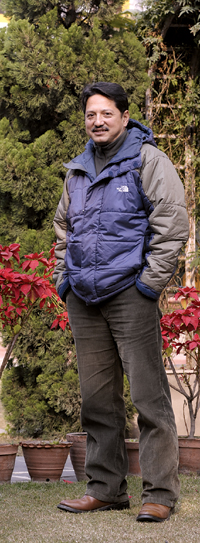Adventure runs through Rajendra Suwal’s veins. Suwal, managing director of NepalNature.com and general manager of the Kathmandu Guest House, has already had a lifetime of exploration, adventure and discovery in Nepal’s mighty wilderness and he doesn’t plan on stopping any time soon. A conservationist and biodiversity expert by profession, Suwal is a fountain of knowledge about the wild animals that call Nepal home. As a prominent member of the tourism industry, Suwal is the go-to source for trekking and mountaineer expeditions.
 Suwal is now an expert on trekking and tours in Nepal, but he recalls a time when he and six friends, all around 13 years old, set off into the Helambu region with little more than a map, cooking utensils and sleeping bags. The cost of the trek was a paltry 100 rupees per person for the entire trip. “We calculated that it would take us two days to reach our destination. But it ended up taking us more than four days,” Suwal said with a laugh. “By the time we reached home again, we had only 50 paisa left in our pockets, but all six of us thoroughly enjoyed it. That’s a trek I’ll always remember.”
Suwal is now an expert on trekking and tours in Nepal, but he recalls a time when he and six friends, all around 13 years old, set off into the Helambu region with little more than a map, cooking utensils and sleeping bags. The cost of the trek was a paltry 100 rupees per person for the entire trip. “We calculated that it would take us two days to reach our destination. But it ended up taking us more than four days,” Suwal said with a laugh. “By the time we reached home again, we had only 50 paisa left in our pockets, but all six of us thoroughly enjoyed it. That’s a trek I’ll always remember.”
Since those early days of unbridled adventure, Suwal has gone on to work with reputed mountaineers, documentarians and environmentalists. As a conservationist, he has worked with the World Wildlife Foundation, the IUCN and the UNDP. He’s also collaborated with the BBC on a number of nature documentaries, including the famed Planet Earth series which came to Nepal to film migrating cranes over the Kali Gandaki valley. Since Suwal’s career revolves around Nepal’s great outdoors, he’s witnessed a number of changes in the trekking industry, as well as changing attitudes of both trekkers and industry workers.
“In a lot of ways, trekking is easier now,” said Suwal. “Before, there were no toilets, no electricity and you had to stay in local houses or in your own tent.” Things have changed as the industry boomed: now some 30,000 tourists hit the trails to Everest Base Camp alone each year. Suwal says it is great for the country to host these trekkers and mountaineers, but that local Nepalis and foreign tourists must be contentious about environment- friendly practices to employ on trek. Trekkers should be mindful of what kinds of fuel locals are using (wood, kerosene or micro-hydro electricity?) to cook and heat their lodges. If possible, steer away from establishments that use wood for fuel as supporting these places encourages increased felling of nearby trees. If you can, support places that use bio-gas as fuel and always make sure never to leave trash on the trails.
The solitude of the trails, taking in awe-inspiring wildlife and conquering mountains you never thought possible are some of the greatest thrills of Nepal travel, and why people continue to come back. “People love this sort of thing,” Suwal said about Nepal’s alpine culture. “Some people have this great enthusiasm and spirit for the mountains and that’s why they come here: for the mountains, for the outdoors, for the wildlife: because we have everything.”
Some lesser-known vegetable dishes from the southern plains
I’m not a vegetarian but I love vegetables. And whenever I get to the southern plains of Nepal, I try...










